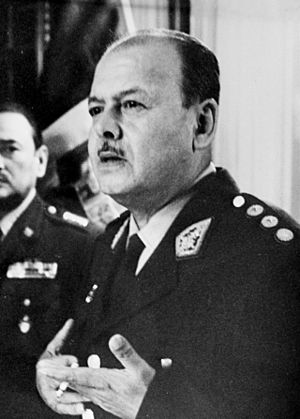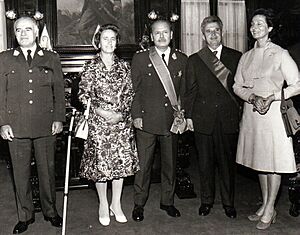Juan Velasco Alvarado facts for kids
Quick facts for kids
General Juan Velasco Alvarado
|
|
|---|---|
 |
|
| President of the Armed Forces Revolutionary Government of Peru | |
| In office October 3, 1968 – August 30, 1975 |
|
| Prime Minister | Ernesto Montagne Sánchez Luis Edgardo Mercado Jarrín Francisco Morales Bermúdez |
| Preceded by | Fernando Belaúnde |
| Succeeded by | Francisco Morales Bermúdez (Constitutional President) |
| General Commander of the Peruvian Army | |
| In office 1967–1968 |
|
| President | Fernando Belaúnde Terry |
| Preceded by | Julio Doig Sánchez |
| Succeeded by | Ernesto Montagne Sánchez |
| Personal details | |
| Born | 16 June 1910 Piura, Peru |
| Died | 24 December 1977 (aged 67) Lima, Peru |
| Spouse | Consuelo Gonzáles Arriola |
| Profession | Army General |
| Military service | |
| Allegiance | |
| Branch/service | |
| Rank | General |
Juan Velasco Alvarado (born June 16, 1910 – died December 24, 1977) was a Peruvian army general. He became the 58th President of Peru after a military takeover in 1968. He led the country until 1975, heading what was called the "Revolutionary Government of the Armed Forces."
Contents
Early life
Juan Velasco was born in Castilla, a city close to Piura on Peru's northern coast. His father, Manuel José Velasco, was a medical assistant. His mother, Clara Luz Alvarado, had 11 children. Velasco often said his childhood was one of "dignified poverty." He worked as a shoeshine boy in Piura to help his family.
He married Consuelo Gonzáles Arriola. Together, they had four children.
In 1929, Velasco traveled to Lima by hiding on a ship. He changed his age to try and join the Peruvian Army as an officer. He was late for the exam, so he joined as a private soldier instead. This was on April 5, 1929. A year later, he took a tough test to enter the Escuela Militar de Chorrillos (Chorrillos Military School). He got the highest score among all who applied. In 1934, he finished his studies with top honors. He was the best student in his class.
How Velasco took power
Before Velasco, Fernando Belaúnde Terry was the President of Peru (1963–1968). During his time, there were many disagreements in the government. President Belaúnde's party did not have enough votes in Congress. This led to a lot of political problems.
Also, from 1964 to 1965, the army had to stop two small rebellions. These groups tried to start a revolution using guerrilla tactics. The army quickly stopped them. But these events made many army officers see how much poverty and inequality there was in the country. They realized that these problems could be a danger to Peru's safety.
A big problem came up with an oil company called International Petroleum Company. There was a dispute over oil fields in northern Peru. A very important page of a contract was found to be missing. This caused a huge national scandal.
The Armed Forces worried that this scandal would cause more unrest. So, they decided to take control of the country. General Velasco took power on October 3, 1968. This was a peaceful military takeover. He removed President Belaúnde, who was then sent out of the country. People's initial anger about the takeover faded quickly. This happened when the army took over the disputed oil fields five days later.
Velasco's time as leader (1968–1975)
Velasco and the other military leaders called their government the "Revolutionary Government of the Armed Forces." Velasco was the President. His government wanted to help poor people. They did this through a plan called "Peruanismo." This plan involved the government taking control of many industries.
Velasco's rule focused on making Peru more independent. He wanted to build strong Peruvian industries. To do this, his government took over many companies. These included companies in fishing, mining, phones, and electricity. The government then ran these companies as monopolies. This meant they were the only ones allowed to operate in those areas. This discouraged private businesses from working in those sectors.
His government also started a big education reform in 1972. This reform aimed to include all Peruvians. It especially focused on the poor and those who felt left out. It also brought in bilingual education for indigenous people. These were people living in the Andes mountains and the Amazon rainforest. They made up almost half of Peru's population. In 1975, Velasco's government made Quechua an official language of Peru, just like Spanish. However, this law was not fully put into practice.
Velasco's government also became very strict. It did not allow people to disagree with its policies. People who were thought to be against the government were sometimes jailed or sent out of the country. The government also closed down and controlled news channels and newspapers. In 1974, they took over all the newspapers.
A very important part of Velasco's plan was the agrarian reform. This program took land from large farm owners. It then gave the land to many farming families. In its first ten years, the government took over 15,000 properties. This was about nine million hectares of land. Around 300,000 families received land. This was the second-largest land reform in Latin American history, after Cuba. Some former landowners felt they were not paid enough for their land. They also said the new owners did not manage the land well.
Velasco's government also tried to make Peru produce more goods itself. This was called "import substitution industrialization." It meant making things in Peru instead of buying them from other countries. The government also controlled foreign money and trade very strictly.
People still discuss how successful Velasco's economic plans were. His government ended up with a lot of debt. This led to the value of money going down and prices going up. This was partly because of the 1970s energy crisis. This crisis made it hard for Velasco to pay for his big plans. However, Peru's economy did grow steadily during his time.
Foreign relations and military

In foreign policy, Velasco was different from other military leaders in Latin America at that time. Most were right-wing. But Velasco became friends with the Soviet bloc countries. He made relations stronger with Cuba and Fidel Castro. Peru also bought a lot of military equipment from the Soviet Union.
Relations between the United States and Peru were difficult. They became hostile as soon as Velasco took power. Just five days after he became president, Velasco started taking over Peruvian industries. He took over the American International Petroleum Company's oil fields. These were in Talara, Piura, where Velasco was born.
The US did not see Peru as a friend after this. The CIA even started making plans to remove General Velasco from power. Disagreements continued over other issues. These included Peru's claim to a 200-mile fishing limit. This led to Peru seizing several US fishing boats. Peru also took over the American copper mining company, Cerro de Pasco Corporation.
However, despite these problems, the US quickly sent help in 1970. A big earthquake killed about 50,000 people and left over 600,000 without homes.
Relations with Chile
General Velasco also wanted to make Peru's military stronger. Peru bought a huge amount of weapons from the Soviet Union. From 1970 to 1975, Peru spent about US$2 billion on military equipment. This included tanks, armored vehicles, and warplanes.
Chile worried that Velasco planned to take back lands lost to Chile in the War of the Pacific (1879). But this was not Velasco's goal. The large amount of weapons Peru bought caused concern. In 1976, US Secretary of State Henry Kissinger met with Chilean President Augusto Pinochet. Pinochet was also a military leader.
In 1999, General Pinochet said that if Peru had attacked Chile in 1973 or 1978, Peru's forces could have gone deep into Chilean territory. Some people believe that the fear of attack by Chilean and US officials was not fully justified. But it was understandable, given that Pinochet had taken power in Chile through a military takeover.
Velasco's removal from power
Economic problems like rising prices, job losses, and food shortages made people unhappy. Velasco's government also faced more opposition after it cracked down on the news in 1974. These problems put a lot of pressure on his government.
On August 29, 1975, several important military commanders started a takeover. This happened in the southern city of Tacna. It was called El Tacnazo.
The military commanders said that Velasco had not achieved the goals of the "Peruvian Revolution." They also said he could no longer lead the country. The new military leaders then chose Prime Minister Francisco Morales Bermúdez to be the new president.
Before he was removed, Velasco had been very ill for at least a year. He had lost a leg due to a blood clot. People said his illness affected his thinking and personality. When the takeover happened, he was recovering at his home outside Lima.
General Velasco quickly called a meeting with his ministers. He realized there was little he could do. He gave a final speech to the nation on the evening of August 29, 1975. He announced that he would not fight the takeover. He said this was because "Peruvians cannot fight against each other."
Death and legacy
General Velasco stayed out of Peruvian politics after he was removed from power. He died in 1977. After his death, farmers carried his coffin on their shoulders for six hours around Lima.
Some people who support left-wing ideas still remember General Velasco fondly. However, his government had only average economic growth. It also left Peru with a lot of debt. His government is also partly responsible for more people moving to the cities. After the land reform, many people moved to Lima and other coastal cities. Velasco's government did not manage this large movement of people well. Later governments also did not pay enough attention to the issue. This led to the growth of poor areas around Peru's cities.
In 1974, a young soldier named Hugo Chávez visited Peru. He was with about a dozen other cadets and soldiers. They went to Ayacucho to celebrate the 150th anniversary of the Battle of Ayacucho. General Velasco personally greeted them there. Velasco gave each of them a small book called La Revolución Nacional Peruana ("The Peruvian National Revolution"). The young soldiers also noticed how close Velasco seemed to be with ordinary Peruvians and the army's soldiers. Chávez really liked this book. He studied it and carried it with him all the time. However, he later lost it after he was arrested for trying to lead a takeover in Venezuela in 1992.
Twenty-five years later, when Chávez became president of Venezuela, he ordered millions of copies of his country's new constitution to be printed. They were made into small blue booklets. This was partly a tribute to the gift Velasco had given him.
Images for kids
-
General Velasco meeting with President Nicolae Ceaușescu of Romania in 1973.
See also
 In Spanish: Juan Velasco Alvarado para niños
In Spanish: Juan Velasco Alvarado para niños



